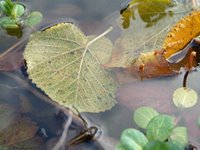
As with most forms of gardening, wildlife gardening requires us to plan ahead. One task this month that could pay dividends next year is to remove fallen leaves from the pond. As leaves rot they release minerals and nutrients. Next spring you could end up with pea soup if the nutrients encourage an algal bloom.
If leaves are left year on year they also form a thick layer of detritus at the bottom of the pond. Although this smelly mud is an important micro habitat, and a small amount should always be present, in severe cases it can silt up the pond, losing depth. Then, as the pond becomes shallower, it offers fewer habitats for animals, plants and microorganisms that require different depths. A silted up small garden pond also becomes an unstable habitat, freezing solid in winter, and becoming warmer than usual in summer. A falling water level due to evaporation also becomes more serious.
 As with most forms of gardening, wildlife gardening requires us to plan ahead. One task this month that could pay dividends next year is to remove fallen leaves from the pond. As leaves rot they release minerals and nutrients. Next spring you could end up with pea soup if the nutrients encourage an algal bloom.
As with most forms of gardening, wildlife gardening requires us to plan ahead. One task this month that could pay dividends next year is to remove fallen leaves from the pond. As leaves rot they release minerals and nutrients. Next spring you could end up with pea soup if the nutrients encourage an algal bloom. 


0 Comments:
Post a Comment
<< Home